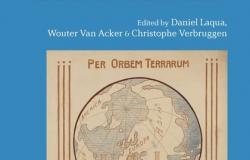Book Review – International Organizations and Global Civil Society: Histories of the Union of International Associations

International Organizations and Global Civil Society: Histories of the Union of International Associations edited by Daniel Laqua, Wouter Van Acker, and Christophe Verbruggen. London and New York: Bloomsbury 2019. 280 pp., £76.50 hardcover 9781350055636
The book “International Organizations and Global Civil Society: Histories of the Union of International Associations“ is an extremely sophisticated work, encompassing different subjects, ranging from history to international relations. The main topic of the book is the Union of International Associations (UIA), its history, vision, activities, publications, and management. However, the book describes the development of the idea (and reality) of internationalism over the last century with a series of chapters dedicated to the UIA and its relations with other organisations and the international system.
 The book is an ambitious editorial project, exhibiting contributions from fifteen authors including the three editors. The book is divided into three parts that slowly guide the reader into a deeper understanding of the UIA and of its main publication, the Yearbook of International Organisations.
The book is an ambitious editorial project, exhibiting contributions from fifteen authors including the three editors. The book is divided into three parts that slowly guide the reader into a deeper understanding of the UIA and of its main publication, the Yearbook of International Organisations.
Part I is dedicated to the foundation of the UIA and its origins based on the initiatives of the fathers of the UIA, above all, Henry La Fontaine and Paul Otlet. The section also addresses the historical development of the UIA, its resilience after the two World Wars, and its struggling for resources and national and international recognition. Chapter one describes the initiatives of the two before-mentioned personalities with the addition of Cyrille Van Overbergh and the emergence of the UIA from previous bibliographical institutions. Chapter two provides a financial understanding of the UIA during its intra-war phase, in which the fundamental role of the two founders La Fontaine and Otet is again well underlined. Chapters three and four conclude this section and develop the premisses for the following one. Through the description of the International University project promoted by the UIA, Chapter three starts describing the vision and the role the organisation had in relation to internationalism and the international order. Chapter four focuses on the years immediately after the Second World War, when the UIA struggled between financial difficulties and the tensions that characterised the international system.
Part II describes the UIA and its relationship with three other organisations: the International Women’s Organisation, the Union Internationale des Villes, and the International Committee of Historical Sciences. Each of these organisations has a dedicated chapter that shows how the UIA relates to the organisations and their causes. This section helps to understand the international and interorganisational position of the UIA and how it has, directly and indirectly, contributed to the promotion of certain values and practices in the international system. The section consolidates the historical studies of the previous one and it closes the discussion on the development and role of the organisation, allowing the third section to focus on the UIA publications, a central topic for researchers and scientists.
Part III is the crucial section of this book for those that are interested in the data and information that the UIA has been gathering for more than one hundred years. Chapter 8 introduces the outputs of the UIA, consolidating their position within wider International Relations (IR) theories. The chapter shows how the UIA has contributed to the understanding of global civil society and global governance, providing important contributions to the definitional and structural debates over international nongovernmental organisations. The chapter offers also a critical view of the use of UIA material, which often has been used too optimistically with regard to global civil society and now sees a challenge by the categorisation of less structured entities such as non-institutionalised transnational social movements.
Chapter nine is equally critical while describing the main publication of the UIA, namely the Yearbook. The yearbook today sees information on more than 75,000 active and inactive organisations, divided into different categories based on the international level of the organisation, management, finances, issue areas and more. The chapter is indeed a core reference for those that are interested in using the UIA data as it presents the Yearbook and the potential pitfalls that its information may have. Moreover, the chapter makes different references to the work of authors that have recently dealt with the criticalities of the data, favouring a constructive discussion on how these issues should and can be addressed.
Focussing on international secretariats, Chapter 10 offers a more detailed look at the information gathered by the UIA. The chapter also offers an example of how the data can be used, providing a brief yet complete analysis of how secretariats of international organisations have developed historically and geographically, and showing how this data contributes to wider debates in International Relations. The chapter also shows how some of the inconsistencies of the Yearbook's data can be overcome with the use of further UIA publications together with other externally available data.
Chapter eleven offers an even more sophisticated analysis of the UIA’s data. Focusing on international congresses, the proposed analysis shows their developments from localised events at the beginning of the second half of the 19th century to a more widespread phenomenon today. The chapter also offers an analysis of the relations among INGOs and work fields over time, also showing the consistency between the results and other available datasets. This section, and the book, end with an epilogue whose authors (and collaborators) are members of the UIA staff today. At the end of a book that starts from the foundation of the UIA, this chapter offers a modern view of the organisation, showing its current activities and challenges, but most importantly, showing that the UIA is very much alive and functioning.
In short, the book is without doubts a publication that many were waiting for. It can be a good reference for historians as well as for political scientists interested in the development and management of internationalism, international organisations (governmental and not), global civil society and global governance. On a more specific note, the book is essential for anybody who wants to use UIA data, as it is the deepest and clearest reference, introducing the organisation and its publications. At the same time, the book is an interesting read for anyone dealing with the international system, and it could also represent good additional reading for IR courses, as it presents a series of case studies and examples that could help students understand better the concepts and the actors they are studying. A final consideration is needed for the hidden pearl of this book: its bibliography. In the different chapters, the authors show great knowledge of the subject they are handling, providing a series of well-known essential references along with more refined publications that are less known, but valuable indeed. It is surely a book that deserves a wide outreach.
Manfredi Valeriani is a GEM-Stones Marie Curie PhD Fellow at Hamburg University and LUISS University. Email: manfredi.valeriani@gem-stones.eu Website: www.manfredivaleriani.com


